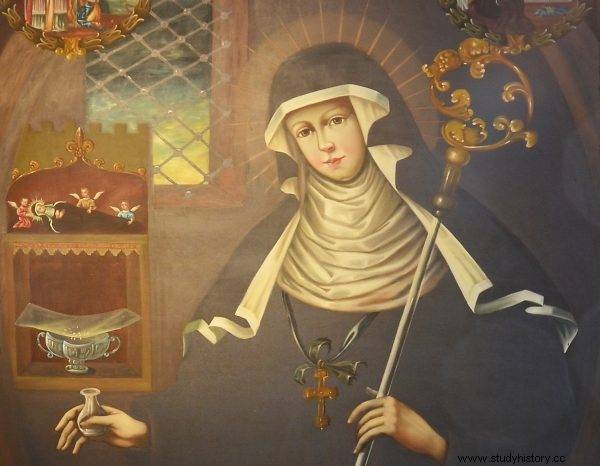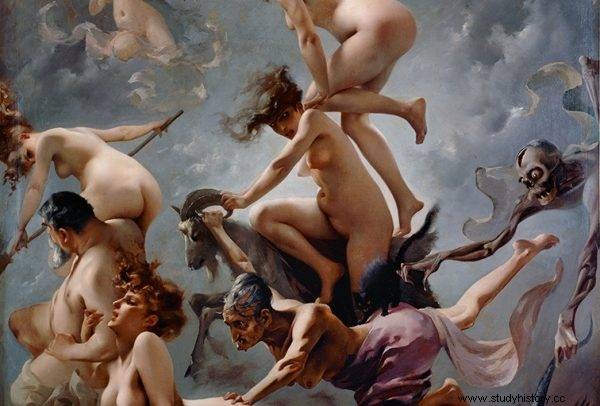On the night of April 30 / May 1, witches gathered on Mount Brocken. They reached Walpurgisnacht on brooms and goats. Where did this strange celebration come from?
The theme of this holiday was used in "Faust" by Johann Wolfgang von Goethe. For centuries, it has been associated with witches' Sabbaths, who confer with Satan on that very night about how to harm people and the forces of good in the near future. This is Walpurgis Night. But are you sure that ordinary people did not stand a chance against witches and hellish powers?
The folk meaning of "witches' night"
In the context of Walpurgis Night, we are dealing with a kind of semantic mish-mash. There was a specific combination of various erstwhile holidays here. The first is the pagan "witches night" and the second is the folk festival , during which took place, among others competitions, about which later. The addition of the Christian festival of Walpurgis complicated the situation even more.
Where does this night of witches even come from? Walpurgis Night was named after the Devonshire-born St. Walpurgis. She was the daughter of Richard, King of England or Duke of Wessex (depending on the source). Her brother was St. Wilibald. She was also the niece of St. Boniface. In the 8th century, she was abbess of the Heidenheim monastery in what is now Bavaria, in Middle Franconia. From around 750, she helped her uncle in missionary work in Germany. Interestingly, he preached, among other things, that belief in witches is a non-Christian attitude.
The figure of St. Walpurgis
St. Walpurga probably lived in the years 710–777 or 778. Unlike many other saints later, she did not become a martyr. She died in the monastery she headed. She was buried in the Church of the Holy Cross in Eichstätt.

St. Walpurga probably lived in the years 710-777 or 778.
As early as the 9th century she was canonized as a witchcraft . May 1, the feast of Philip and Jacob, was designated as her memorial day. According to legend, various demons fled on the night of April 30 to May 1 to take refuge on Mount Brocken. The world could take a break from them for at least one night. According to one version of Walpurg, it was precisely that night that she was on this mountain. Thanks to this, became acquainted with the practices of witches. By the way, she also converted many witches. In the Middle Ages, it was considered that holidays protect people from witchcraft, storms and rabies. To protect yourself from evil, all you had to do was call her name.
Witches' Mountain
Mount Brocken, also known as Blocksberg, is the highest (1,142 m above sea level) peak in the Harz Mountains in central Germany. It was there that every year on the night of April 30th to May 1st witches of various colors were to gather, arriving on brooms, goats and in all other ways on their Walpurgisnacht. Even German children knew that witches then played, feasted, indulged in debauchery and danced with evil spirits. One of them was to be even Satan himself, sometimes depicted as a goat with whom the witches agreed on their plans for the next year and worshiped him during various rituals. It is probably Brocken's top that is referred to by a phrase from sources from the 15th century in which its other name appears:Hexenberg, meaning the mountain of witches.

The place of the Polish coven is of course the famous Łysa Góra.
In Poland, the Walpurgis Night tradition was especially strong for such regions as Kashubia, Silesia and Warmia. This was mainly due to the proximity to German culture. The night of April 30 to May 1 was associated with, inter alia, with the witches' coven that was to be held at that time. He was one of the most important, the so-called the big ones (as opposed to the everyday ones) - next to, for example, the one that takes place on Midsummer. Another such occasion was St. Lucia. The place of the Polish coven is of course the famous Łysa Góra.
How to protect yourself from evil on Walpurgis Night?
For centuries - apart from, of course, the intercession of St. Walpurgis - people looked for different ways to prevent evil from having access to them on this particular night. It was believed that evil spirits would keep the bells ringing until dawn. Generally, after dark, it was possible to forget about the curfew at night. The sound was also supported by light. It was believed that where light and sound go - witches are not allowed there. So fires were lit and houses were rounded up with flaming torches. Sometimes it is even mentioned that with burning brooms - trophies won by burned witches.
The doors, even to the stables and barns, had to be marked with a cross. Both in front of houses and cowshed, it was also possible to hang bunches of properly selected herbs. Processions and indulgences were organized. It was also advised to go to the Stations of the Cross, and to sprinkle holy water around the house. It was mentioned in a 19th-century encyclopedia that humans also coped with firing small arms into the wind, shaking trees, and slamming a whip.

In Poland, the Walpurgis Night tradition was especially strong for such regions as Kashubia, Silesia and Warmia.
One of the publications in the Giant Mountains also mentions ways to recognize witches and prevent them from entering their home. For the first purpose, had to put something on the left side, and then go to the nearby crossroads after 11 p.m. . This was to guarantee the ability to "see" witches. What to do to prevent them from entering the homestead? Occupy them with something - even counting! You could put twigs around the house, plant flowers or sprinkle sand. The witches were only allowed to enter after they had counted leaves, seeds or grains of sand.
Customs related to Walpurgis Night
On St. In the countryside, Walpurgis boys jumped through gallows made of willow branches. For the one who proved to be the most dexterous, it bode well for the best. This information was given in relation to the Lusatians. A slightly more widely known custom is the one from the 12th and 13th centuries. It consisted in organizing various types of competitions that day. Their winner was considered a symbol of the god of light who conquered darkness and even hell. He had the right to marry any maid he wished. There was no question of gender equality - the young lady had nothing to say about it.
An interesting habit was also preparing the so-called poles in May . They were trees decorated with colorful ribbons - for the chosen ones. They were to stand for another month. If, of course, someone did not snatch them out of jealousy. Interestingly, the tradition of the pillars was also explained by the Christian legend associated with St. James and Philip. They were to be locked in a house marked with twigs. The next day, the same twigs appeared in front of houses all over the neighborhood. This made the escape of the saints much easier.

According to legend, various demons fled on the night of April 30 to May 1 to take refuge on Mount Brocken
The date April 30 had an additional meaning in medieval Sweden. The administrative year was ending in that country. , which became an occasion to celebrate, especially for city dwellers. But the tradition of Walpurgis Night also reached Sweden. It is called Valborg there, which is a shorter version of Valborgsmässoafton. In the countryside at that time, animals were released to pastures and fires were lit. They tried to make as much noise as possible to scare off predators, but probably also evil forces - including, of course, witches. A more modern version of this unusual holiday came to Sweden with the arrival of German immigrants, who mainly lived in Uppland. Nowadays, this night is also a student festival.
Satanist festival?
In a specific way, Walpurgis Night was connected with Satanism in the 20th century. Well on the night of April 30 to May 1, 1966, during a ceremony in San Francisco, the Church of Satan was founded. Its founder was Anton Szandor LaVey, a former lion trainer, illusionist graduated in criminology. He became the High Priest and Magician of the Black Rite. Just two years later, he published an "unholy" book:The Bible of Satan.
It is amazing how many different holidays were managed in just two days, between April 30 and May 1. So many different genes, so many meanings ... Perhaps this kind of "accumulation" additionally contributed to the fact that various traditions of Walpurgis Night have survived to this day . And they still arouse interest. Apparently, people are still drawn to this "dark side of the force" ...
